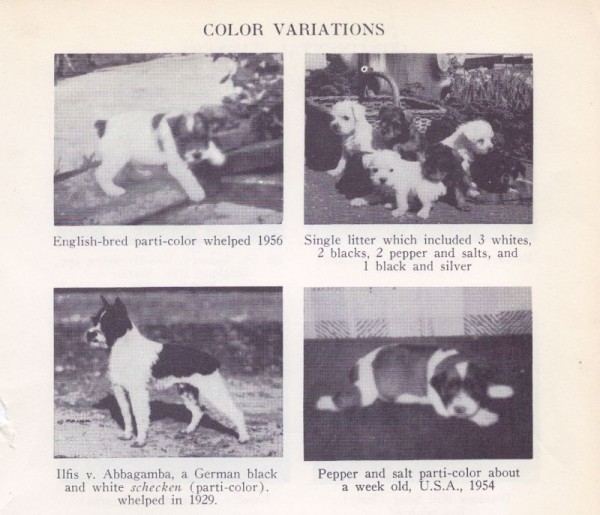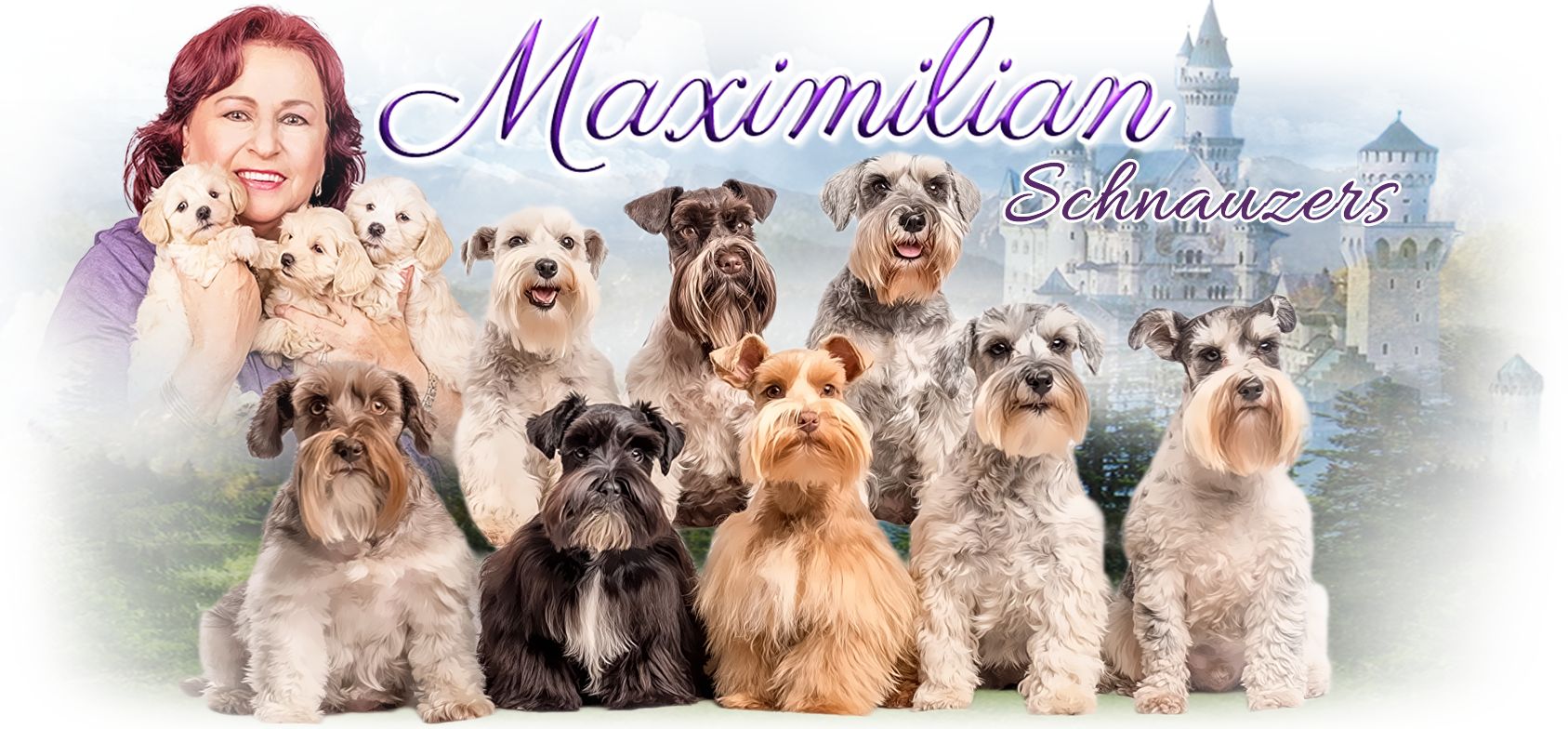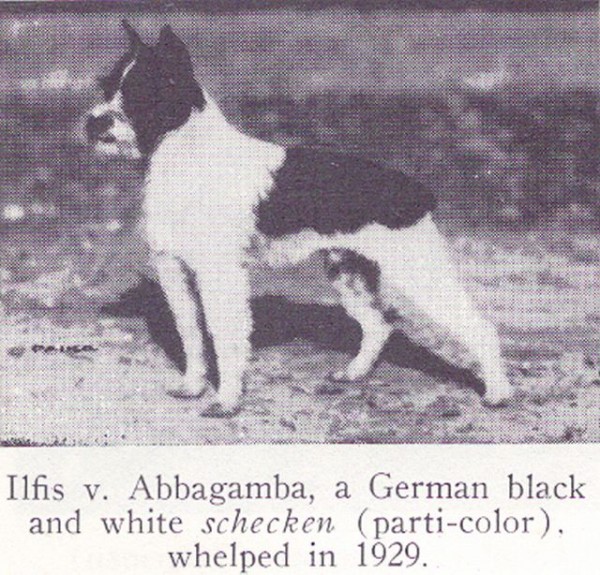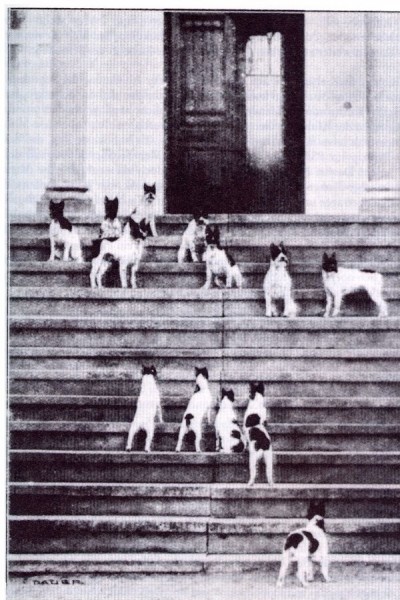About Black to White Miniature Schnauzer Colors and Those In Between Colors!
Litters of purebred black parents commonly produce puppies with white markings on the toe tips, at the chin, on the chest and at the tip of the tail. This is caused by the so-called “prenatal pigment stop.”These markings disappear in the first few weeks. However, this is often the beginning of the Parti pattern and if animals with these permanent white patches are mating with one another, the markings of the offspring will normally be significantly larger than those the parents have.
The disposition for white patches is recessively inherited. Paired with an animal without this disposition, the Parti pattern does not appear because the disposition for full pigmentation dominates over the disposition for white patches. However, the disposition can be imparted invisibly from single-colored animals across several generations until one day – as luck would have it – a carrier of this genetic trait mates with a partner whose genetic material also contains this disposition.

“The Complete MINIATURE SCHNAUZER” by Anne F. Paramoure, 1959 Edition
All Those In Between Colors – other than the usual Pepper and Salt, Black and Black and Silver –
are pretty much non-existent here!
So let’s explore the rich and complex world of Miniature Schnauzer colors. First, the Official view…
Official vs Accepted Miniature Schnauzer Colors
Germany is the country of origin of the Miniature Schnauzer breed. Germany’s Pinscher Schnauzer Club recognizes four acceptable Schnauzer colors:
* Black
* Pepper and Salt
* Black and Siver
* White Schnauzer
Ironically, the US, Canadian, British and Australian Kennel Clubs decided to ignore German guidelines and establish their own criteria for judging the Miniature Schnauzer. For example, none of them regard the White Miniature Schnauzer as an acceptable color and in Britain, even Black and Silver is not accepted!
Why?
Well, the Breed Standards were set by people, not God! A group of enthusiasts simply decided they liked this or that and thus “outlawed” any “off” color. Actually, while Pepper and Salt was quickly standardized, even Black, and Black and Silver were not readily accepted at first. However, though you can’t compete in the Show ring with dogs bearing other colors, many unofficial colors are still “allowable” in registered purebreds, and dogs of such colors can compete in other Kennel Club competitions such as agility and obedience.
These accepted – but unofficial – colors in the US are:
* White Miniature Schnauzer
* Chocolate or Liver (Brown) Miniature Schnauzer
* Parti (which is white with patches of another color
• Black and Silver Miniature Schnauzer
• Chocolate or Liver and Tan Miniature Schnauzer
• Liver and Pepper Miniature Schnauzer
• Silver or Platinum Miniature Schnauzer
• Wheaten Miniature Schnauzer
You’ll also occasionally hear mention of “Phantom” coloring, which (unofficially, of course!) describes dogs with very pale, almost white furnishings, of any of the following colors: Black and silver, Chocolate or Liver and Tan, or Black and Tan.
So that’s the official line…
Obviously, breeders breeding for the show ring do all they can to eradicate the non-official colors from their lines. This has led to an unfortunate attitude of “color-prejudice” against them within such circles.
Take this comment for example:
There’s no such thing as a PURE-BRED “phantom” or “parti” or “liver” miniature schnauzer puppy. There are actually people who know so little about breeds that they think that a liver-colored schnauzer is pure-bred. Ummm…NOPE! They have been crossbred with another breed to get that color.
Obviously not true!
While they are disqualified from the show ring, such dogs are still recognized as purebreds by the AKC (American Kennel Association).
Where Did All These Colors Come From?
Given the many breeds that were used to down-size the Standard Schnauzer to produce the first Miniatures, it’s not surprising that “non-official” colors have appeared in the breed.
Indeed, varying shades of Liver or Chocolate were prominent in the early days of the breed.
At least one dog from the first litter recorded in the Miniature Schnauzer studbook was “gelb” – German for yellow – i.e. a brown based dog with pale pigment deposition.
“Parti” colors too, commonly cropped up in these early litters, and were also recorded from a pair of black dogs belonging to the Abbagamba Kennel in Germany in 1929, and again from a mating of two Pepper and Salt dogs in the USA.
So, while they can’t compete in the Show Ring, there is nothing wrong with the other colors as many like to argue. They are 100{1ae7e102a3dea989efbafce106c15cccf456ca1949ba5bcb97e243b0e6c61c0e} purebred Schnauzer, and can be duly registered.
Further, the Parti and other colors are extremely “old blood”, found in most of the early lines.
Miniature Schnauzer Colors
Miniature Schnauzers come in three basic colors genetically – either black (with a black skin) or liver (with a brown skin).
Then there’s the true White Miniature Schnauzer which is genetically a dog with the color turned “off” so that it has white hair and pink skin.
Banded: Banded describes the default color of the Schnauzer. When no other genes are at play, a banded color is the result. Therefore it is the most common Miniature Schnauzer color, The Salt and Pepper Schnauzers
Banded coloring in the more common (and genetically dominant) black based dogs produces the Pepper and Salt and in the brown based dogs, the Liver Pepper.
The Pepper and Salt has banded hairs in shades of gray to black with lighter silver furnishings on the eyebrows, beard, legs, and under the tail.
This color can range from a very pale silver dog to a very dark nearly black dog. In the Liver Pepper the tones are identical but in shades of liver.
One Color: The gene that codes for the “one color” appearance is dominant to the banded color.
Schnauzers that are genetically one color are black if they are genetically black based, or liver if they are brown based.
The Black Schnauzer is completely black, and has no banded hairs on it but may have a little white on the chest, for example (though this is not desirable in the Show Ring).
And similarly the Liver is completely brown but can have some small white bits also.
Because some Schnauzers also carry genes that code for fading- either all over or just in specific places – dogs that are genetically the same one color can appear quite different at maturity.
At maturity a one-color brown based dog can appear so dark brown (liver) as to be almost black, or so pale as to appear almost white (wheaten).
Bi Color: Bicolor expresses as Black and Silver in black skin dogs, and Liver and Tan in the browns. It is genetically recessive to the banded color.
The Black and Silver Schnauzer has a black body coat and silver furnishings. The body coat will show no banding at all (or else it is actually a dark Pepper and Salt!).
The same is true of the brown dogs, but in liver shades: solid liver body with tan to silver furnishings.
Parti: “Parti” describes patches of any size or color on ‘White’.
There is a Parti version of all Schnauzer colors. The Parti gene is genetically recessive, so needs to be inherited from both parents to be expressed.
No Color and White Miniature Schnauzers
There is quite a range of genetics that can result in White Miniature Schnauzers. However, the only pure White Miniature Schnauzers are genetically a “no color” dog having pink skin and no other coat coloring whatsoever.
This is a recessive trait.
Outlaw Miniature Schnauzer Colors:
The Chocolate Schnauzer and Parti Schnauzer.
These Miniature Schnauzer colors existed in original German breeding lines, the Chocolate Schnauzer and Parti Schnauzer are outlaws in many Schnauzer circles.
Why Outlaws?
Well, for a start, these colors do not exist in the Standard Schnauzer, from which the Miniature was developed in in the 1800s.
Interbreeding with Poodle, Miniature Pinscher, Affenpinscher and others was used to scale down Schnauzer size. This inadvertently brought new color genes into our Mini version that didn’t exist in Schnauzers previously.
Here we are talking primarily about the genes behind the Liver or Chocolate Schnauzer and the Parti colored Schnauzer.
So purists have historically rejected these “outlaw” Miniature Schnauzer colors so that they are disbarred from competing in the Show Dog arena.
Such color prejudice led to culling of these colors from breeding stock which makes them relatively rare today.
However, dogs displaying these colors can still be registered as purebred Mini Schnauzer stock and their popularity with pet owners is nurturing a revival in their numbers.
The Chocolate Schnauzer
The Chocolate Schnauzer – more correctly called the Liver Schnauzer – differs from most because it carries the gene for brown.
Miniature Schnauzers can be either black based (with black skin, nose, pads and hair pigment) or brown based (with brown skin, nose, pads and hair pigment).
Only the black based colors are recognized in the Show Ring – Salt and Pepper, Black, and Black and Silver.
To compound their rarity, the gene that codes for brown based coloring is recessive to the black based coloring.
That means both parents must carry and pass this gene to their puppies to get this coloring.
Because of additional genes that code for coat color fading, and coat color masking, there is a range of Liver or Chocolate Schnauzer coloring intensity.
They can be any hue from very dark Liver to pale wheaten cream, or, if their color is masked, pure white (the so-called White Chocolate). All, however, will have brown skin, nose etc.
The Parti Schnauzer
Yet another gene (there are several!) that influences Miniature Schnauzer colors is the Parti gene.
This is, again, a recessive gene that codes for “broken color”. As such it can modify any of the other colors.
So all Breed Standard accepted black based colors can come in Parti versions, as well as all the basic brown based colors.
Parti denotes any color on a pure white background.
The pattern can be in the form of large saddles of color, as a splattering of colored freckles, or both, anywhere on the body.
You can also have a pure white dog that is genetically actually a Parti whose color expression is being covered up by a masking gene.
As is the case when this occurs in the Liver or Chocolate Schnauzer, the only sign is skin pigmentation.
The White Schnauzer: When
White Miniature Schnauzers
Ain’t White!
While the White Schnauzer is officially recognized in its native Germany, White Miniature Schnauzers are accepted – but not considered desirable -under the Breed Standards of many other countries. Crazy but true!
However, that doesn’t prevent White Schnauzers from being very much desired by breed enthusiasts.
So… What is a White Miniature Schnauzer?
When it comes to the Miniature Schnauzer white ain’t white! That’s because there are several – genetically different – types of apparently White Mini Schnauzer.
Let’s take a look at them!
Pure White Schnauzers
The only pure White Schnauzers are genetically a “no color” dog having pink skin, pink nose and no other coat coloring whatsoever. Genetically they have their color genes “turned off”.
True White Mini Schnauzer
Like the pure White, “true” White Miniature Schnauzers are born white. But here the resemblance ends, as they are never really pure white, but will also show cream and beige.
In this color schnauzer, white is masking over the real genetic color of the dog.
If they are genetically banded like the pepper and salt then cream or beige banding variations will be apparent in the white coat.
When non-banded colors are masked by white, however, the only thing that is apparent is their base color i.e. whether they are brown (liver) – in which case their color is often described as “White Chocolate” – or the black based “True White”.
The only way then to tell what the masked color of their coat is genetically is to breed them and see what colors turn up in their offspring. If they are bred to dogs that don’t carry the masking gene then the will throw true to their underlying genetic color that the white masking is disguising.
Fading to White Miniature Schnauzers
These “False White” dogs appear white at maturity but are born a light tan color that fades as they age.
They are simply one color dogs that have strong expression of the fading gene.
If they are black based they will fade to “Platinum”, and if brown based they fade to “Wheaten”.
Though they may have pinkish nose and pads (if their toes are white), its not the true pink of the Pure White.
Unlike the other types of White, this one is dominant genetically.
Parti colored White Mini Schnauzers
Parti colored Schnauzers can inherit all the same genes for fading that any other Schnauzer can.
So we can end up with white looking adult dogs that are actually technically Parti due to the characteristic patches of pigmented skin over pink skin.
More about colors with pictures

.jpg)




.jpg)
